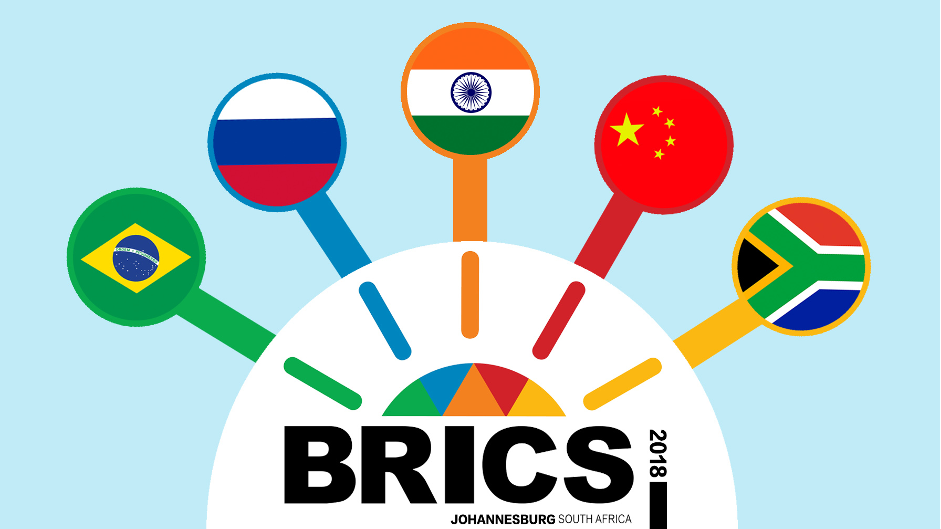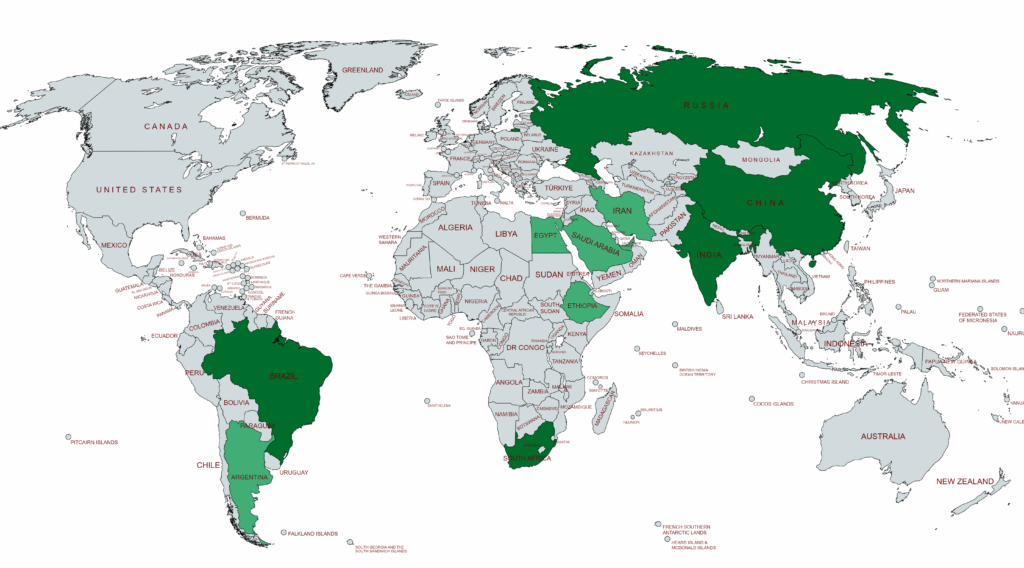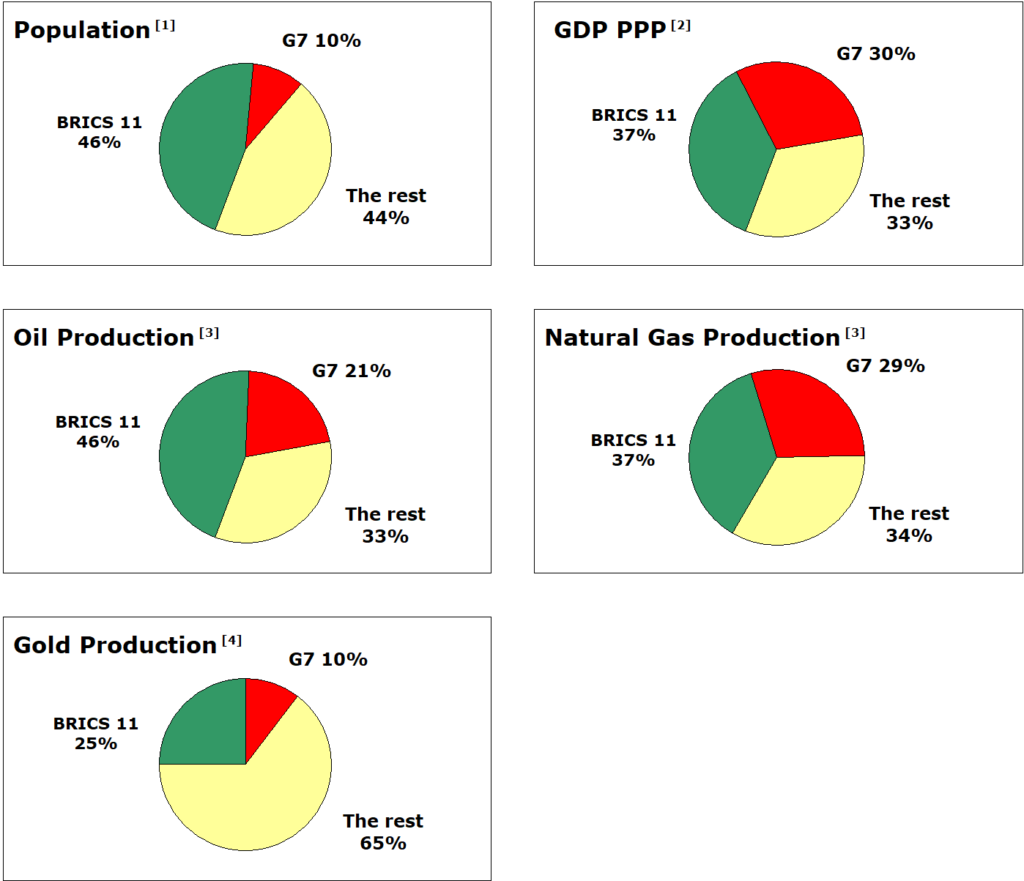BRICS – Series – Part 4 – BRICS becomes BRICS 11
How does BRICS look after the summit in Durban? – What was announced? – What does the future hold?
Peter Hanseler

Introduction
On August 24, the BRICS Summit in Durban, South Africa, wrapped up.
The most important news is certainly that from January 1, 2024, the following six countries will become full members:
Argentina, Egypt, Ethiopia, Iran, Saudi Arabia and the United Arab Emirates.
Thus, as of today, we can call this organization BRICS 11.
In part 1 of our series we collected many facts and figures about BRICS and organizations in the haze.
In the 2nd part we dealt mainly with today’s international monetary system, which is dominated by the petrodollar, its history and the reasons why BRICS & Co. want to break out of this system.
Then, the 3rd part dealt with the heterogeneity of the previous and possible further BRICS members and the related challenges, also trying to guess what might have been decided at the just ended summit.
In this 4th part, we will talk about the decision-making process that led to the admission of these six countries and the immediate consequences of these admissions.
After that, we will present the figures of BRICS 11.
Then we will briefly discuss the status of the BRICS single currency.
Finally, we will briefly discuss the 26-page declaration with its 96 points.
How did the decisions come about?
Heterogeneity
In Part 3, we discussed why BRICS is a very heterogeneous community and to what extent this is an opportunity but also a challenge for the community.
In this association, the Chinese and the Russians are close in their geopolitical view and have – due to their power – a very large influence on South Africa and Brazil, which are both closely linked to China and Russia in terms of trade.
India, on the other hand, takes a much more open course toward the West than China and Russia and is the second colossus in this community next to China: India wants to get along with everyone, i.e. they do not choose a side – Global South or Collective West – but try – and so far with great success – to get along with everyone somehow.
In the short term, India could be seen as a brake on BRICS 11, but in the long term, I personally see an advantage in the challenge of fully integrating flexible India into BRICS and taking its reservations about further members and economic thrust seriously. If this is not done, BRICS will run the risk of degenerating into a chattering club like the UN, G7 or G20, and thus becoming an organization that never achieves anything first, because the members concerned do not take what they say seriously themselves. BRICS is still much more credible than organizations dominated by the collective West and has good chances to keep this advantage.
“A compromise was found with Egypt, Iran, Saudi Arabia, the UAE, Ethiopia and Argentina.”
The negotiations for the new members
President Putin – ever the realist – described the negotiations concerning the election of the new members as very demanding. He seems to be well aware of the difficulties of heterogeneity as the leader of the largest country in the world with over a hundred peoples.
India – cautious as always – wanted 3 new members, China wanted 10. A compromise was found with Egypt, Iran, Saudi Arabia, the UAE, Ethiopia and Argentina.
Russia supported Egypt. The most obvious plus point in favor of Egypt’s inclusion is a logistical one: the Suez Canal. The Suez Canal is an important route for energy, raw materials, consumer goods and supplies from Asia and the Middle East to Europe.
China, which imports huge amounts of energy to run its gigantic economy, was counting on the Persian Gulf: it wanted Iran, the United Arab Emirates and Saud Arabia. This is no surprise: Iran and China already have a strategic partnership, and Riyadh already accepts the yuan as payment for its oil. The United Arab Emirates, which still contributes 4.3% to global oil production, is also emerging as a major financial center that could bridge the gap between BRICS 11 and the West. It is thus evident time and again that BRICS and its members – in contrast to G7 – also take an inclusive stance toward the West. BRICS 11 thus does not want to close itself off from the West in any way.
Brazil and China support the inclusion of Argentina, and South Africa supported Ethiopia.
India initially had major reservations about the inclusion of the three oil giants Saudi Arabia, Iran and UAE. Religious reasons may have played a role, which have been stoked by the U.S. for decades. However, Russian Foreign Minister Lavrov, who enjoys the highest respect in India, managed to appease the Indians.
India’s caution is, of course, also related to the fact that this giant empire does not want to provoke its partners in the West too much and certainly fears sanctions. The other two giants – China and Russia – no longer have these problems, since they are already being sanctioned.
Russia, which has been the energy giant – oil and gas – of BRICS, shows once again that multipolarity is not just a buzzword for the giant empire. Russia has no problem at all in welcoming the biggest competitors in terms of oil and gas into this community and has been actively campaigning for their inclusion.
From BRICS to BRICS 11 – The Immediate Consequences
New Power Structure in the Middle East
The inclusion of the three Persian Gulf countries leads to a strong concentration of power of BRICS 11 in terms of energy.
With the addition of the three energy giants, BRICS 11 directly controls 46% of global oil production (G7-21%) and 37% of global natural gas production (G7-29%).

However, these figures show only – or not even – half the truth. BRICS 11 will dominate OPEC+ with the new big oil producers as members.
OPEC+ controls 59% of the world’s oil production – all detailed figures on all organizations can be found in Part 1.
Further, it must be remembered that while the US is the world’s largest oil producer with a market share of just under 18%, it consumes just under 20% of the world’s oil production and thus not only cannot supply oil to other countries in the collective West, but is dependent on imports. Furthermore, U.S. oil is about 2.5 times more expensive to produce than that of Saudi Arabia.
“Geopolitically, the admission of the Persian Gulf states is a complete disaster for the United States.”
Thus, the G7 is completely on the defensive on the energy level already. As of today, they are dependent on BRICS 11 for oil and natural gas. Especially in the EU, some headless and aggressive loudmouths will be tearing their hair out. How do you get energy from a community whose biggest energy producers you call a war criminal, a scoundrel state and an war enemy? Quote from Ms. Baerbock: “We are at war with Russia.”
Geopolitically, the admission of the Persian Gulf states is a complete disaster for the US. This blog already stated several times that the peace agreement between Saudi Arabia and Iran alone deprived the USA of the possibility of the tactic “divide et impera”.
With the affiliation of the three states in BRICS 11, the power over the Middle East, which until now – besides the petrodollar – probably represented the most important element of the world domination of the USA – nota bene without war, but with peace – was knocked out of the hand of the USA.
Furthermore, the peace agreement between Saudi Arabia and Syria deprives the U.S. in the Middle East of any justification to continue stationing troops in Syria. Syria, back in the Arab League, will be able to quickly dispose of Americans sitting illegally in Syria’s oil fields. The implausible and hackneyed rationale of fighting terror will be of no use to the Americans. All they can do is spark a direct war against Syria or turn tail and leave Syria. After Afghanistan, this will probably be the second embarrassing setback for the Americans within a very short time, which will further worsen the geopolitical reputation of the USA. Do you remember President Barak Obama’s arrogant speech at a press conference with Turkish Prime Minister Recep Tayyip Erdogan? – His words, “Assad needs to go.” That was in 2013 – today it would be fair to say, “The Americans have to go.” Further we refer to our article “Peace breaks out – Arab Spring without blood“, which also deals with the Arab League.
Spring Feelings in South America
Argentina, once one of the richest countries in the world, which has collapsed again and again for decades because of its U.S. dollar debts, will have a huge opportunity to get out of the vicious circle of bankruptcies and become a jewel once again with its admission to BRICS.
A prerequisite for this, however, is that the Argentine people elect a president who can get the country back on its feet.
The phenomenon of Javier Milei is ready and waiting. Not surprisingly, he is portrayed by the West as a right-wing extremist. If he is elected and Milei succeeds in bringing discipline to Argentina’s coffers, BRICS will control South America with Brazil and Argentina.
Venezuela has also applied to join BRICS 11. This country has the largest oil reserves in the world. However, Venezuela is completely down economically – I wonder why?
Venezuela is also terrorized by the USA. It should be unthinkable to sanction such a great country whose people are actually starving. The Americans do not like the government in Venezuela. In 2019, they tried to use Juan Guaidó as a puppet of the USA – this failed miserably. As a reason for the sanctions, the Congressional Research Service attributes in its report “Venezuela: Overview of U.S. Sanctions” that the sanctions were enacted to combat terrorist activity, drug and human trafficking, corruption and human rights abuses. A very credible assessment. While the population is suffering on an unspeakable scale, this terror will not produce results in Venezuela either.
Venezuela, which already has very good relations with Russia and China, will probably join BRICS 11 in 2024.
BRICS 11 in numbers
After our readers have received pretty much all the numerical material regarding BRICS, their future and all organizations of the Global South in Part 1, it is now our pleasure to present you with the hard numbers of BRICS 11. These numbers will give the Collective West a stomach ache as early as 2024.



Single currency
In part 3 we pointed out that due to the heterogeneity of the members of BRICS, especially due to the ideology-free attitude of the Indians, a sudden change of the world on the occasion of the just finished summit was not to be expected.
Many clever experts, among them James Rickards, expected the announcement of a single currency on the occasion of this summit, although the Indians stated a few weeks before the summit that a single currency was not on the agenda at the moment.
Our blog was more cautious with its predictions – as it has now turned out – and rightly so.
However, I still consider James Rickards’ comments to be very valuable and, above all, correct. I just think he was a bit too optimistic with the timing. A single currency, which will be used to settle payments between members, is by no means off the table, in my view.
But much more important than the timing of the introduction of such a settlement mechanism is the immediate effect of BRICS 11 on monetary systems – or shall we say more accurately – the petrodollar.
BRICS 11 and many countries aspiring to BRICS 11 membership will from now on no longer settle their trade transactions among themselves in U.S. dollars, as far as that is possible.
This was precisely the statement made by Russian Foreign Minister Sergei Lavrov at the summit.
Many people are not aware of the consequences of such a circumvention of the US dollar in any way. Here we refer to our Part 2 of our BRICS series, where we meticulously lay out what the petrodollar means for the American economy and world domination. At the risk of appearing repetitive or even pretentious, I would like to point out once again that U.S. domination or its demise cannot be seriously discussed or debated if the petrodollar system is not understood in its fundamentals.
The process of detachment from the corset of the petrodollar will continue and it is quite possible that, for example, Russia – as the first country in a hundred years – could turn its currency – the ruble – into the gold ruble.
In any case, the final declaration, paragraph 45, contains an indication that members are working on this issue in a concentrated manner and that news can be expected in the near future:
“We task our Finance Ministers and/or Central Bank Governors, as appropriate, to consider the issue of local currencies, payment instruments and platforms and report back to us by the next Summit.”
The final declaration
The declaration, which is 26 pages long in the original language, lists 94 points. I am truly not a diplomat and therefore I will not go into detail about the text. Only this much: the text is the largest common denominator of all members and thus certainly worth reading.
You can read the final statement on this blog: The original final declaration was published in English, the Kremlin published it in Russian. Incomprehensibly, the German government refrained from making the declaration available to its population in German until now – we have made up for that for you here.
Conclusion
Don’t let the Western coverage of this summit mislead you into thinking it’s not a very important event – it is.
“The USA will use any means not to lose this power.”
In our series, we tried to shed light on many aspects of this community and provide food for thought. We will stay on the ball and report regularly on the further development of BRICS and other organizations.
I consider this development to be very positive for the Global South, but I would like to point out once again that the danger for world peace increases with the success of BRICS.
The greater the success of BRICS will be, the more pressure will be on the petrodollar. The petrodollar is the foundation of the USA as a world power. The USA will use every means not to lose this power. My fear is that the USA will lead our earth into a world war. I know these are gloomy thoughts, but unfortunately they are merely a logical consequence of what is happening before our eyes.
13 thoughts on “BRICS – Series – Part 4 – BRICS becomes BRICS 11”